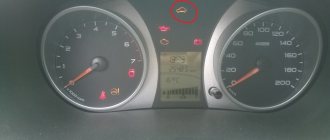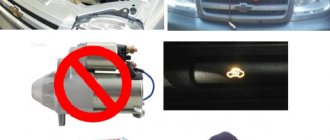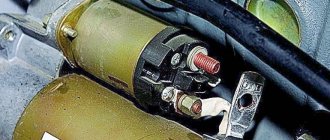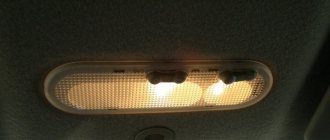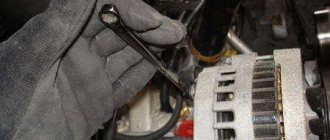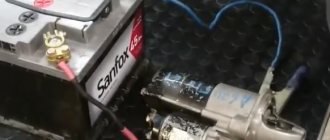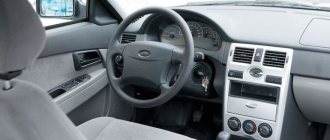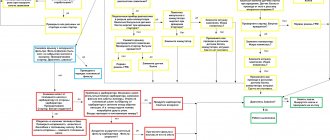Among the many surprises that a car can present to a motorist is a refusal to start the engine.
There are many reasons for this misunderstanding. One of them is a starter malfunction. Also, when the car does not start, the starter does not turn, the reason may lie in some auxiliary systems. The fault may be the battery, problems in the electrical circuits, or a malfunction of the solenoid relay.
Be sure to read the article by our specialist, in which he talks in great detail about how to repair the starter yourself.
Headlights and instrument lights flicker
Thank you, your link clarified something, I will check the generator..
And my Akuma lamp is smoldering and sometimes there is flickering. and charging occurs at idle 14.7. what is the reason?
Body weight. In the area of the left headlight (where the battery is). Vibration causes the wire to twitch and thus flicker.
Guys, my headlights and interior lights are also flickering. What is the problem? Thank you.
The voltage is jumping, look at the generator, most likely the brushes. And when the engine is not running, do they flicker?
Definitely a gene. Somehow my gene bearing died at the dacha. I found a local store and service, they installed a new generator. So far in the summer I was driving quietly because... It gets dark late, and I didn’t drive at night, so I didn’t notice the flickering of the light. In the fall, I start it early in the morning, and the lights in the cabin are blinking, the headlights, the instrument lighting, in general, the onboard network is behaving badly. When you turn off the car, everything lights up smoothly. I contacted a company that specializes in repairing the gene and starters. True, they are not allowed into the repair area, but the defect was eliminated. Their verdict was that the contact of the regulator relay was not sufficient; the fastening was not tightened, although the gene was new.
Automotive electronics are extremely complex from the point of view of diagnostics and repair, especially if several elements or connecting wires fail at once. At the same time, a modern car cannot exist without electronics, and the driver is obliged to maintain it in good condition. If you happen to encounter such a problem as blinking headlights at idle engine speed, it is necessary to identify its cause as soon as possible and eliminate it, which will be discussed in this article.
Broken ground contacts
This problem manifests itself on the panel by displaying incorrect information; the tachometer needle may drop below the current level. The needles of other instruments may also freeze , either permanently or for a short period of time. The panel backlight may also disappear, but the arrows will show the correct data.
Bolt for fixing ground wires from all devices
Through trial and error, it was found that these glitches can occur due to the fact that the ground contact is broken . Under the dashboard, near the driver’s right foot (near the gas pedal), there is a special mount to which ground wires from all instruments are fixed.
To solve such a malfunction in the operation of the VDO dashboard, you simply need to improve the contact . Unscrew the bolt at “8”, disconnect and clean all contacts suitable for it. To be safe, it is advisable to treat them with “electronic contact cleaner”. After this, all that remains is to connect the wires and screw the bolt back.
When some of the hands work and some don’t work at all, the reason is most likely in their drive motors. Then the panel can only be repaired by replacing the pointer drive motors.
Bottom line of the route display
If you have stopped switching the parameters that are displayed in the bottom line of the route display (under the total or daily mileage), then the problem lies in the steering column switch.
It is responsible for switching between the following options:
- current time;
- outside air temperature;
The buttons on the switch work every once in a while
- travel time (valid from the last reset);
- average fuel consumption;
- instantaneous fuel consumption (changes as the vehicle moves);
- average speed since reset;
- residual power reserve with the remaining fuel in the tank;
- amount of gasoline consumed since reset.
How lighting works in cars
To solve the problem with blinking lights at low engine speeds, you first need to understand the process of operation of automobile lighting devices. Like all electronics on a passenger car, lighting fixtures operate at a constant voltage of 12 volts. To transmit voltage, a single-core wire is used, along which a positive charge flows, and a negative charge passes through the car body.
A three-phase alternator and battery are responsible for powering the vehicle's electrical devices. There is also a rectifier in the circuit.
Generator overload
If the battery is charging, but the voltage is insufficient, it means the generator is overloaded. This is facilitated by the installation and connection, in addition to standard electrical equipment, of various gadgets that require electricity. The generator is operating at the limit of its capabilities.
Modern drivers love various car tunings. Thus, serious music systems, powerful lighting and other equipment are installed. Someone also increases the battery power. So, with a 70 Ah battery, the standard VAZ generator cannot fully charge it. It just doesn't have enough power. As a result, the generator provides little charge.
What to do if the headlights blink at idle
Having superficially understood the principle of supplying voltage to electrical appliances, we can conclude that the flickering of the light is most likely due to a malfunction of the generator. To make sure of this, you need to check the generator voltage, which can vary depending on the make of the car, but is usually in the range from 14 to 15 Volts.
If, as a result of checking the generator, it was discovered that its voltage does not correspond to the recommended values, two options are possible:
- The alternator voltage is higher than recommended by the vehicle manufacturer. In such a situation, it will be necessary to replace the generator; most likely, it has failed;
- The alternator voltage is lower than recommended by the vehicle manufacturer. You can try tightening the belt drive that goes to the generator from the engine pulley.
It is worth noting that in some service centers specialists repair the generator. You can try contacting specialists who will check the device on a special diagnostic stand and determine whether it can be repaired or better replaced.
How to determine that the generator is not charging the battery
The easiest way to check that the generator is not charging (VAZ-2110 is no exception) is by looking at the dashboard. There is a control lamp on it. Classic VAZ models also have a voltmeter. The arrow should be in the green zone, and the control lamp should be in normal mode (when everything is working properly, it does not light up). If this is not the case, then charging does not occur. It is worth considering the problem in detail.
Diagnostics
To accurately detect misfires on cylinders 1 and 4 of the VAZ 2114, it is necessary to perform computer diagnostics. It is carried out using a special electronic module connected to the diagnostic connector. After starting the scan, the computer will automatically produce results in the form of special codes corresponding to certain errors.
Diagnostics of VAZ 2114
So, for misfires there are codes:
- P0301;
- P0302;
- P0303;
- P0304.
In this case, the last digit in the code corresponds to the number of the faulty cylinder. For example, misfire in cylinder 1 of a VAZ 2114 will be designated as P0301 and so on...
Emergency engine starting methods
When the starter does not click or make any sounds at all, the engine can be started if it is closed “directly”. This is not the best solution, but in cases where you need to go urgently and there is no other option, you can use it.
Let's consider the situation of how to start the engine directly using the example of a VAZ-2110 car. So, the sequence of actions will be as follows:
- engage neutral gear and set the car to the handbrake;
- turn on the ignition by turning the key in the lock and open the hood, since we will carry out further actions in the engine compartment;
- remove the air filter from its seat and move it to the side in order to get to the starter contacts;
- disconnect the chip going to the contact group;
- use a metal object (for example, a screwdriver with a wide flat blade or a piece of wire) to short-circuit the starter terminals;
- as a result of this, provided that the other components listed above are in good working order and the battery is charged, the car will start.
After this, install the chip and air filter back. An interesting fact is that in most cases the engine will continue to be started using the ignition key. However, you should remember that the breakdown still remains, so you need to look for it yourself or go to a car service center for help in order to fix it.
Emergency engine start
We offer you another method that will be useful to you if you need to start the engine in an emergency. It is only suitable for front wheel drive passenger cars with manual transmission! The algorithm of actions is as follows:
- it is necessary to jack up the car by hanging any of the front wheels;
- turn the hung wheel outwards all the way (if the left wheel - then to the left, if the right wheel - then to the right);
- wrap a tow rope or strong rope around the surface of the tire 3-4 times, leaving 1-2 meters free;
- engage THIRD gear;
- turn the key in the ignition;
- pull strongly on the end of the cable, trying to spin the wheel (it is better to do this not in place, but with a slight run-up);
- when the car starts, first of all set the gear to neutral (you can do this without pressing the clutch pedal) and wait until the wheel stops completely ;
- lower the hanging wheel to the ground.
When carrying out the procedure described, be extremely careful and follow the necessary safety precautions so as not to injure yourself or damage the machine.
The described method of spinning the wheel of front-wheel drive cars is reminiscent of the method of starting a crooked starter (using the crank) used in old rear-wheel drive cars (for example, VAZ “classic”). If in the latter case the starter is spun using a handle, then in front-wheel drive cars it is spun from the axle shaft on which the raised wheel is located.
Conclusion
The starter is a simple but extremely important mechanism in a car. Therefore, its failure is critical , as it does not allow the engine to start. In most cases, problems are related to the car's electrical wiring, poor contacts, broken wires, and so on. Therefore, if the starter does not turn over and does not start the engine, the first thing we recommend is that you inspect the contacts (main ground, relay contacts, ignition switch, etc.).
Additional
How to remove the gearbox
But everything is much worse if the starter spins, but does not turn the engine, and metallic sounds are heard. This means that you will need to remove the gearbox and replace the flywheel crown. Since you are going to climb here, remember how long ago you changed the clutch. If you don’t remember when, then purchase a kit - a disk, a basket, a bearing and six bolts. The procedure for removing the gearbox is not easy, so it is expensive to carry it out again. First of all, disconnect all the wires going to the gearbox and the speedometer drive cable. Now drain the oil, while simultaneously monitoring its appearance.
After this, disconnect the drives - remove the internal CV joints from the gearbox. Please note that both hinges cannot be removed at the same time! First dismantle the first one, then put a plug in its place. After that, just take out the second one. Otherwise, the differential will be destroyed, and you will have to disassemble the box to repair the damage. Then you hang up the engine and gearbox and remove the cushions. However, this is where the preparation is over. Now just unscrew the bolts or nuts that secure the box to the engine. And you can do the undocking.
Other causes of starter failure
The reasons listed above are not the only ones. There is also a short list of problems that indicate a faulty starter. These include:
• brush wear;
• winding short circuit;
• breakdown of the bendix fork;
• the return spring has moved out of place;
• the magnets installed on the starter have come unstuck.
• bendix teeth are worn out, etc.
In this case, a slow rotation of the crankshaft is observed. This happens because the oil in the engine is too thick, or the battery is discharged.
There are situations when the starter does not work when the engine is hot, but after it cools down it begins to function normally. In this case, the problem lies in the wrong size bushings. Perhaps they are smaller than they should be. As they heat up, the holes inside them become wider and the shaft jams. After cooling, everything returns to normal.
